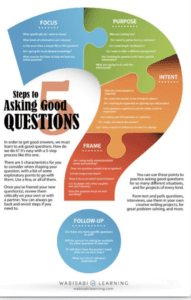What role does questioning play in learning?
Most of us can probably agree that asking quality questions can greatly impact learner engagement while promoting critical thinking and deepening learning. But many organizations in the business of lifelong learning might not be incorporating effective questioning strategies into the design of their learning experiences.
In this episode of the Leading Learning podcast, Celisa and Jeff talk about the role of questions and questioning in learning, why it is such an important topic, and what learning businesses can do to encourage questioning.
To tune in, just click below. To make sure you catch all of the future episodes, be sure to subscribe by RSS or on iTunes. And, if you like the podcast, be sure to give it a tweet!
Listen to the Show
Read the Show Notes
[00:18] – Thank you to YourMembership, the podcast sponsor for the third quarter of 2017. YourMembership’s learning management system is specifically designed for professional education with a highly flexible and intuitive system that customizes the learning experience. YourMembership’s LMS seamlessly integrates with key systems to manage all of your educational content formats in one central location while providing powerful tools to create and deliver assessments, evaluations, and learning communities.

[01:14] – Highlighted Resource of the Week – An infographic from Global Digital Citizen which covers a 5 step process for asking good questions by thinking about focus, purpose, intent, framing, and the follow-up of questions.
Why talk about questions?
[01:41] – Questions in many ways are the lifeblood of learning. The effort of formulating and asking questions helps us be more aware of what we don’t know.
The answers, of course, help to address our knowledge gaps. They are very often a key means of drawing connections between the content and concepts that comprise a learning experience and also connecting this new knowledge to what we already know. They are basically a key technique in what is known in learning theory as “elaboration.”
Questioning is really at the heart of establishing relevance in any learning experience.
Is this relevant to what I do? Is it relevant to who I am? How is it relevant? How would I apply it?
These are the kinds of questions that always going through a learner’s mind, whether consciously or unconsciously – and they are a form of elaboration, or more specifically, elaborative interrogation.
It may be a bit of an overstatement – but not much of one – to say that if we are not asking questions, we aren’t really engaged in learning.
Most organizations in the business of learning want to engage their learners and whether or not questions are asked in the context of a learning experience is one of the clearest signs of whether there is engagement.
How can we encourage questions?
[03:52] – In spite of providing content that clearly aligns with learner needs, and doing your best to present the content in an effective way, you often get mostly crickets when it comes to questions.
Below are some approaches to encourage questions:
- Clearly establish receptivity to questions
- Make it crystal clear how to ask questions – seems obvious, but it’s often overlooked – i.e., how to use the question panel
- Provide white space – you have to give people enough cognitive room to formulate questions
- Model good, relevant questioning – build it in to the learning experience.
- Coach learners on how to ask better questions – this is not a skill that most people are taught.
How to ask – and encourage – better questions
[06:18] – To address how to ask better questions, Dr. Fiona McPherson (who has done significant research in many areas of learning and memory) makes some great resources available on her site Mempowered.
Effective questioning is an area in which she is particularly interested and she did an excellent post a while back on how to ask better questions.
Below are the three key questions she asks to determine the overall quality of any question:
- Does it make the information more comprehensible? – does it surface details or related information that helps us to understand better?
- Does it make the information more meaningful? – does it give us a better idea of why it matters?
- Does it increase the number of meaningful connections? – does it relate the new knowledge to what we already know or do?
Dr. McPherson examines these primarily from the standpoint of studying and illustrates how you would use them to help commit factual information to memory.
They can also be used as a simple checklist for how participants in conference session, seminar, online course, Webinar, or other typical adult learning activity might approach questioning, as outlined below (and think about actually sharing this checklist with learners – on a whiteboard, flipchart, handout, etc.):
- Do I really understand what has been said, shown, demonstrated, etc.?
- Is it clear to me why it matters?
- How does this connect to what I already know and do?
Socratic questioning
[11:00] – One of the oldest and best-known forms of question-based learning – the Socratic method, comes from Socrates, the Greek philosopher and arguably one of the greatest questioners of all time.
He used different types of questions to encourage his students to explore, test, and deepen their views, opinions, and knowledge.
There are four different types in particular, the ignoramus, the gadfly, the stingray, and the midwife:
- The ignoramus type of questioning may be the easiest to understand. You basically play dumb and act like you’ve never encountered the topic or issue–unless you truly never have encountered the topic or issue, in which case you don’t have to play dumb. So typically ignoramus questions are, “What does that mean?”; “I don’t understand—can you explain again?”
- Gadfly-type questions are little questions intended to push thinking and avoid sloppiness: “What evidence do you have?” “How can you be certain that is true?” “Is that always true?” “Does that always apply?”
[14:20] –
- The stingray-type questions are meant to administer a little shock to thinking in the same way a stingray unleashes its sting. Questions that make you reconsider: What if your premise were wrong? What if everything you’ve said was turned on its head? Imagine if X wasn’t the case, what then? What if you had unlimited time and resources?
- Midwife questions are those that help give birth to ideas: “That’s an interesting idea. How did you think of it? Could you explain your idea a bit more?” “What are the implications for your idea?” “How might your idea affect things?”
Note we used this type of questioning at Learning • Technology • Design (LTD) 2016 and we suggest using this as an activity as part of your learning experience/learning event using the following framework (note this can be done in real time but could also be done on a discussion board):
- Put learners in groups of 2 to 4
- Each person shares something learned or something done in the learning experience
- One person responds to what’s shared with a question
- Repeat as time allows
[19:10] – We can practice getting better at questions and knowing about the 4 Socratic types is one way to build your questioning muscle.
Another is an improv activity that helps your fluency—you state a prompt, situation, topic, and people interact based on that prompt, but they can only speak in questions.
And the questions can’t just be, “Why do you say that?” or “Why not?”.
They have to be substantive and build and get more fluent with appropriate questions. It also undercuts the pretty strong desire most of us have to answer a question vs. respond with another question—a useful mind shift.
[21:10] – Wrap Up
Thanks again to YourMembership for sponsoring this episode of the Leading Learning podcast.
If you are getting value from the Leading Learning podcast, be sure to subscribe by RSS or on iTunes. We’d also appreciate if you give us a rating on iTunes by going to https://www.leadinglearning.com/itunes.
Also, consider telling others about the podcast. Go to https://www.leadinglearning.com/share to share information about the podcast via Twitter, or send out a message on another channel of your choosing with a link to https://www.leadinglearning.com/podcast.
[22:47] – Sign off
See Also:


 Taming Information Chaos with John Mancini of AIIM
Taming Information Chaos with John Mancini of AIIM
Leave a Reply